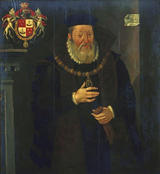 |
||||||||
| Portrait of James Hamilton, 2nd Earl of Arran and Duke of Châtelherault (d.1575), attributed to Arnold Bronckorst (fl.1566-83) | ||||||||
 © Lennoxlove House Ltd |
Formerly hanging in Hamilton Palace, South Lanarkshire, now at Lennoxlove, East Lothian At one time believed to be by Cornelius Ketel, this portrait, which has always been in the Hamilton Collection, is now attributed to Arnold Bronckorst. This Netherlandish artist visited Scotland in the 1580s and had probably been here before, because it is likely that it was he who painted the young King James VI in 1574. In oil on oak panel, Arran’s picture measures 115.57 x 107.95cm and is dated on the paper to his right. The date is usually read as 1578 but this does not look like a posthumous portrait and the last digit is unclear. Perhaps it is actually 1574. The inscription also states that he is in his 56th year. |
|||||||
|
James, 2nd Earl of Arran, was for many years heir presumptive to the Scottish throne, for he was a descendant of James I. Had Mary, Queen of Scots died before the birth of her son James VI, Arran would have succeeded her on the throne. As it was, he ruled Scotland as Lord Governor (Regent) for a considerable part of her minority, before being ousted by Mary of Guise in 1554. A vacillating character easily influenced by people of stronger personality than himself, Arran nevertheless had a great talent for self-preservation. In 1548 he had been rewarded by Henry II of France with the dukedom of Châtelherault and the Order of St Michael (which he wears round his neck in this painting) in return for his agreement that Mary, Queen of Scots should marry the Dauphin. Opposing the queen’s marriage to Darnley, he retired for some years to France, remaining there until 1579, by which time she had been defeated at Langside and had fled to England. Failing to claim the position of Regent to James VI, he supported the queen once more and was imprisoned for a time in Edinburgh Castle. He did not long survive his release, dying at Hamilton on 22 January 1575. |
||||||||
|
|
|
|
|
|
|
|
|
|